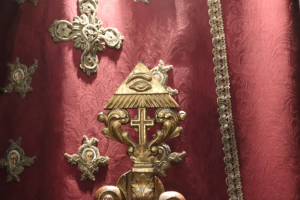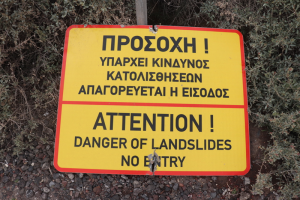We started the day at Metaxas (Mavromatis) quarry outcrop, which magnificently displayed all four phases of the Minoan eruption. It was rather windy, and many of us suffered some degree of corneal damage due to flying pumice (aka glass) shards.
The Quarry: All phases, 1, 2, 3, and 4, are visible here. Phases 2 and 3 comprise the tens-of-meters thick deposit seen above. Phase 4 caps phase 3 in dark grey and is several meters in thickness.
A refresher on the Minoan eruption:
The eruption began with precursory explosions that left two lapilli fallout layers and a phreatomagmatic ash (phase 0). Phase 1 is up to ~6 m thick and contains up to a few percent of andesitic scoria. The deposit is comprised of a reversely-graded unit that is overlain by a coarse, normally-graded unit.
Phase 2 deposits (seen here) include pyroclastic surge deposits with multiple beds, which can undulate or pinch out lenticularly. This deposit grades upwards into the low-grade ignimbrite of phase three, the most voluminous of the three phases. At the caldera wall, it is nearly ~60 m. Lithic blocks >1m in diameter populate the massive to crudely-bedded deposit.
At the end of the day, we went to the southern coast and got another perspective on phases 3 (the white-ish bottom layer) and 4 (the weathered brown layer above, from which holes and caves have been excavated by the wind & sea spray). Overall, the Minoan deposits are >99% rhyodacitic pumice.
Following our trip to the quarry, we ventured into illegal territory (see above sign) to check out the “red beach” – so named for the scoria cliffs that periodically collapse and extend the beach (see below).
Our third stop was archaeological, to examine the 3600-year-old ruins of Akrotiri colonized by Theracians (NOT “MINOANS”). Above is a trading post/street-side store, where goods were kept in large pots about a meter in height. The Theracians were quite a sophisticated people, having developed their own form of indoor plumbing, with toilets that piped sewage to a communal repository. Houses could be a few stories tall (higher than what is presently permitted in Santorini!). Frescoes adorned most walls and often featured seasonal landscapes.
 The ruins were in a climate-controlled building (see above). At best, only ~10% of the ruins have been uncovered.
The ruins were in a climate-controlled building (see above). At best, only ~10% of the ruins have been uncovered.
We visited Pyrgos for lunch and walked around the city to admire the old and well preserved buildings. We saw the inside of the very newly renovated Church Theotokaki (or Panagia church) and learned about restoration processes for old paintings (circa 1800s). The church is on the highest point of the hill of the city, and stands like a fortress with a great view of Santorini. All of the roads lead up to the Church (more or less), and are small and winding with a cobbled pavement.
 Newly restored art in the church
Newly restored art in the church
 Potential evidence for the Illuminati in the Greek Orthodox Church?
Potential evidence for the Illuminati in the Greek Orthodox Church?
 MORE evidence of the Illuminati?? (Look below the cross)
MORE evidence of the Illuminati?? (Look below the cross)
Outside Church Theotokaki and in the town of Pyrgos…
 Flags decorate the church area in preparation of the Greek celebration of independence from the Ottoman Empire.
Flags decorate the church area in preparation of the Greek celebration of independence from the Ottoman Empire.









